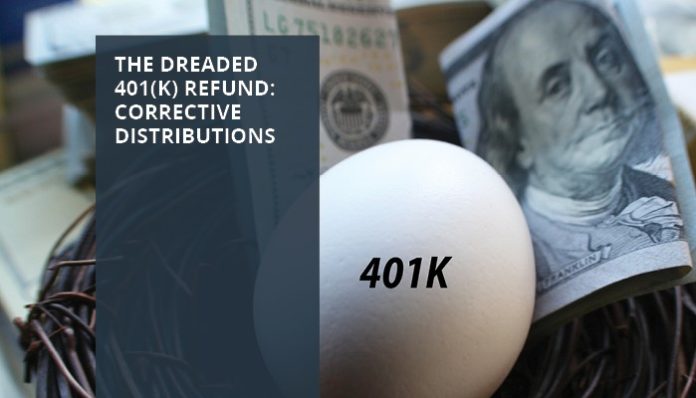401K REFUNDS: NOT AS GOOD AS THEY SOUND
With tax season fresh on our minds, many hear the word “refund” and begin running down their imaginary wish list of ways to spend this extra money. However, when it comes to 401(k) refunds, or corrective distributions, there really is not much excitement experienced by those who receive them.
Corrective distributions are a headache for plan sponsors and employees alike. Essentially, these refunds mean that your plan has failed testing, and tax-deferred money that key employees set aside for retirement must be returned to them. This is an issue for both you and your employees. In this article we will discuss what these tests are and suggest some things you can do to prevent refunds in future years.
HIGHLY COMPENSATED EMPLOYEES
Your workforce is made up of two distinct employee demographics: highly compensated employees (HCEs) and non-highly compensated employees (NHCEs). An HCE is one who owns 5% or more of the company, is a direct family member of an owner, or earns more than $125,000 per year. NHCEs make up the remaining portion of your workforce.
These two groups share a common goal of reaching retirement, and although HCEs may be able and willing to contribute more, your plan should be designed with both parties in mind. The IRS requires that both highly compensated plan participants and all other plan participants contribute to their 401(k) plans at similar rates.
UNDERSTANDING TESTING REQUIREMENTS
If the idea of calculating and comparing percentages sends you down a path of traumatic flashbacks of math class, don’t worry. The goal here is to simplify and educate, not overwhelm. Once you have the basics down it gets easier to understand the implications of testing and what you can do to help alleviate any issues with refunds in the future.
ADP TESTING
ADP stands for actual deferral percentage. This test compares the average salary deferral percentages of HCEs with the average salary deferral percentages of NHCEs. The ADP test applies to pre-tax and Roth elective deferrals. The purpose of this test is to ensure that all employees are benefitting from the plan. To pass ADP testing, the average contributions of HCEs must not exceed NHCE contribution by a factor of 1.25 or 2 percent as illustrated in the chart below:

ACP TESTING
ACP stands for actual contribution percentage test. It is similar to the ADP test, only it tests employer matching contributions. So, ACP only applies to companies that offer a company match. It compares the average percentage of matching contributions and after-tax employee contributions for HCEs versus NHCEs. The ACP test uses the same passing requirements as the ADP test, illustrated above. It is also possible that a plan can pass one and not the other.
TOP-HEAVY TEST
The Top-Heavy test looks at how much HCEs contribute to the plan compared to everyone else. If HCE and Key Employee balances exceed 60% of the entire plan balance at the end of the plan year, the employer is required to make a corrective contribution that includes lost earnings to the non-key employees to be non-discriminatory. The contributions are generally about 3% of compensation.
WHAT IF A PLAN FAILS TESTING?
401(k) test failures are no fun for anyone. Swift action is required for employers and plan sponsors as refunds need to be given to the affected employees within 2 ½ months after the end of the plan year being tested (e.g. March 15th for 12/31 plan yearend). To correct plan failures, additional contributions may be required, or corrective distributions would need to be made. This means that a specified portion pre-tax savings be returned to owners and key employees in order to satisfy testing. These “refunds” will need to be included in their taxable income for the year in which the funds have been returned. Usually this is not a welcome check to be received and might come with a lot of questions. It is important to take corrective action on any plan testing failures, since failing to do so within a specified period will mean excess penalties and potential loss of tax-qualified status.
The simple answer is yes, if the plan sponsor decides to take advantage of some plan design features that will allow a plan to automatically satisfy some of the required testing rules, which eliminate future refunds due to failed testing. A Safe Harbor Plan eliminates the need for non-discrimination testing altogether. These plans automatically pass ADP/ACP testing when certain contribution and participant notice requirements are met. To fulfill the requirements, employers must make one of the following contributions:
Basic Matching – The company matches 100% of all employee 401(k) contributions, up to 3% of their compensation, plus a 50% match of the next 2% of their compensation.
Enhanced Matching – The company matches at least 100% of all employee 401(k) contributions, up to 4% of their compensation (not to exceed 6% of compensation).
Non-Elective Contributions – The company can choose to make a non-elective contribution of not less than 3% of compensation to all eligible employees, regardless of whether they defer under the 401(k) arrangement. The 3% contribution must be set by the plan document and may provide that this contribution be made to only Non-Highly Compensated Employees. Utilizing the Non-Elective Contribution might be beneficial to a plan that also provides a weighted profit-sharing contribution, since the 3% required contribution can be included as part of the profit-sharing calculations.
Qualified Automatic Contribution Arrangement or QACA Safe Harbor Match – The QACA safe harbor matching contribution formula is a 100% match on the first 1% of compensation deferred and a 50% match on deferrals between 1% and 6%;
- A two-year cliff vesting schedule may be applied to QACA safe harbor contributions; and
- Unless the participant elects otherwise, the deferral rate starts at no less than 3% and increases at least 1% annually to no less than 6% (with a maximum of 10%).
While these Safe Harbor plan design options allow owners and highly compensated employees to maximize deferrals, they do require specified employer contributions, and all contributions are immediately vested. Another factor to consider is distribution of employee communication. Plan sponsors are responsible for notifying participants of their plan rights and obligations within 90 days of their plan eligibility date and 30-90 days before the start of each new plan year thereafter.
Other plan design options can also provide some help in reducing the amount of, or completely eliminating, refunds without giving up the advantages of the vesting of employer contributions. A plan may consider implementing automatic enrollment with automatic increases, look to utilize a stretch matching formula, or considered using prior year testing as a basis for testing. Each of these options come with other considerations that the plan sponsor needs to weigh based on their desired outcome for the plan participants and the employer contributions available to be made to the plan.
Cabana LLC (dba “Cabana Asset Management” and “Cabana Retirement Solutions”), is an SEC registered investment adviser with offices in Fayetteville, AR and Plano, TX The firm only transacts business in states where it is properly registered or is exempted from registration requirements. Registration as an investment adviser is not an endorsement of the firm by securities regulators and does not mean the adviser has achieved a specific level of skill or ability. Additional information regarding Cabana, including its fees, can be found in Cabana’s Form ADV, Part 2. A copy of which is available upon request or online at https://www.adviserinfo.sec.gov/.
This information was developed as a general guide to educate plan sponsors and is not intended as authoritative guidance or tax/legal advice. Each plan has unique requirements and you should consult your attorney or tax advisor for guidance on your specific situation.

